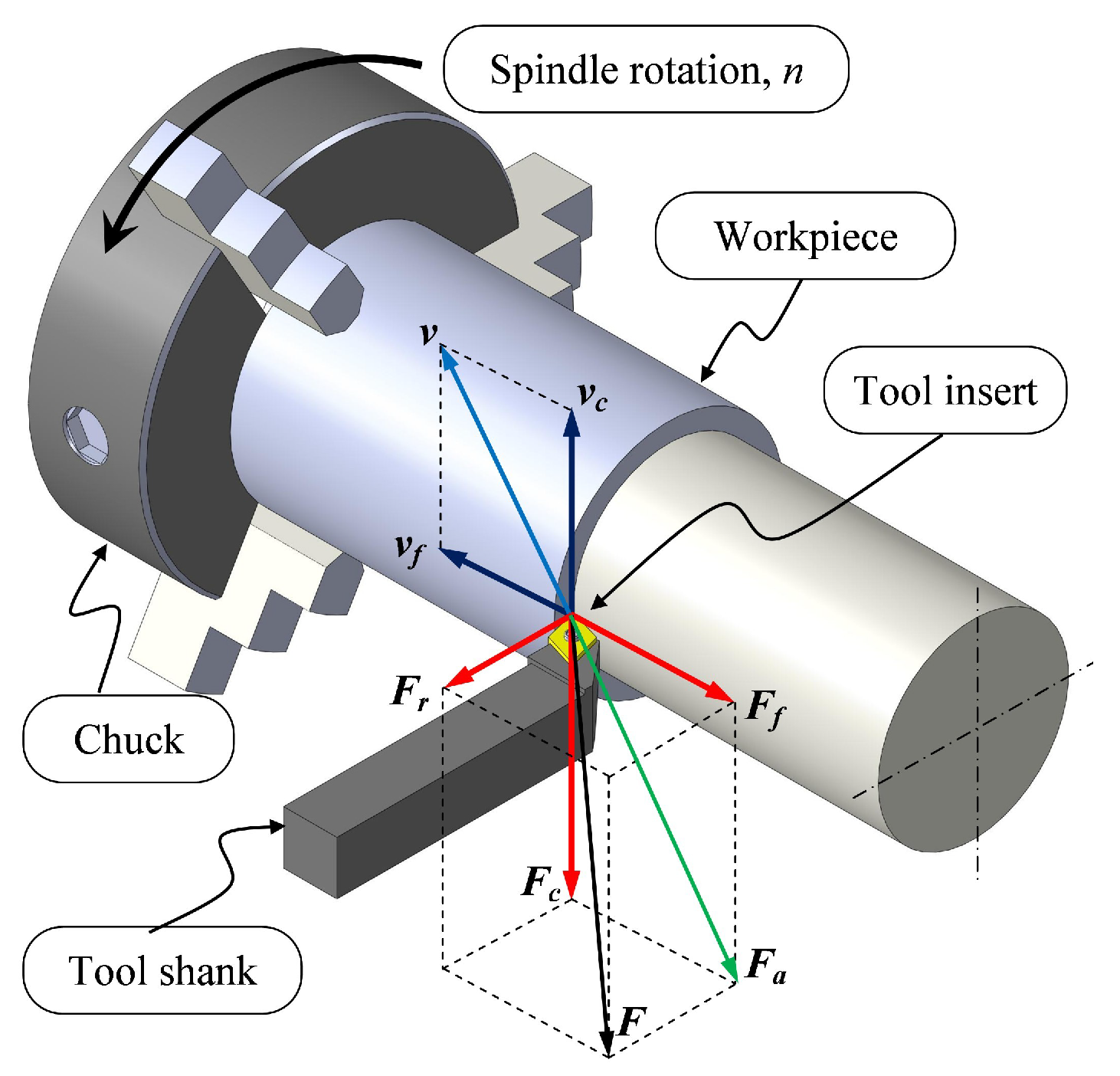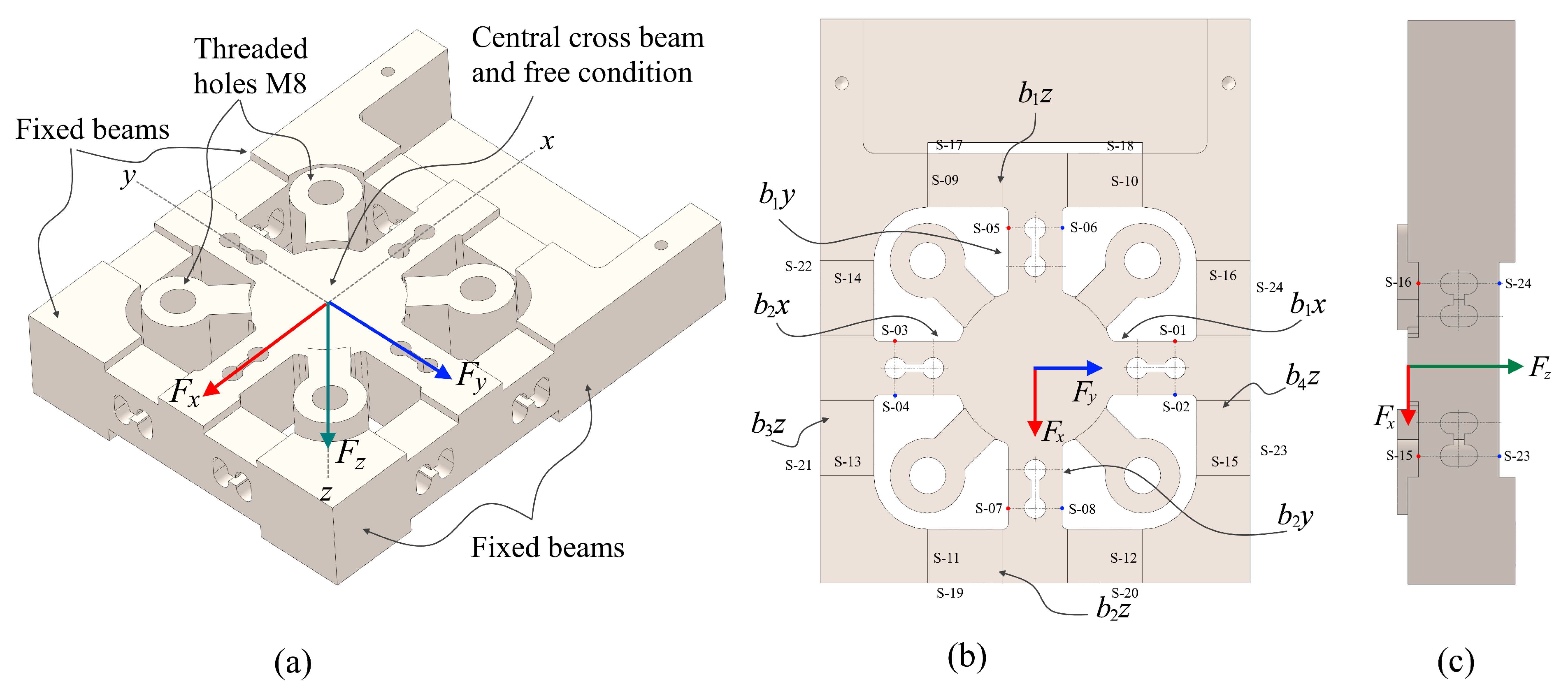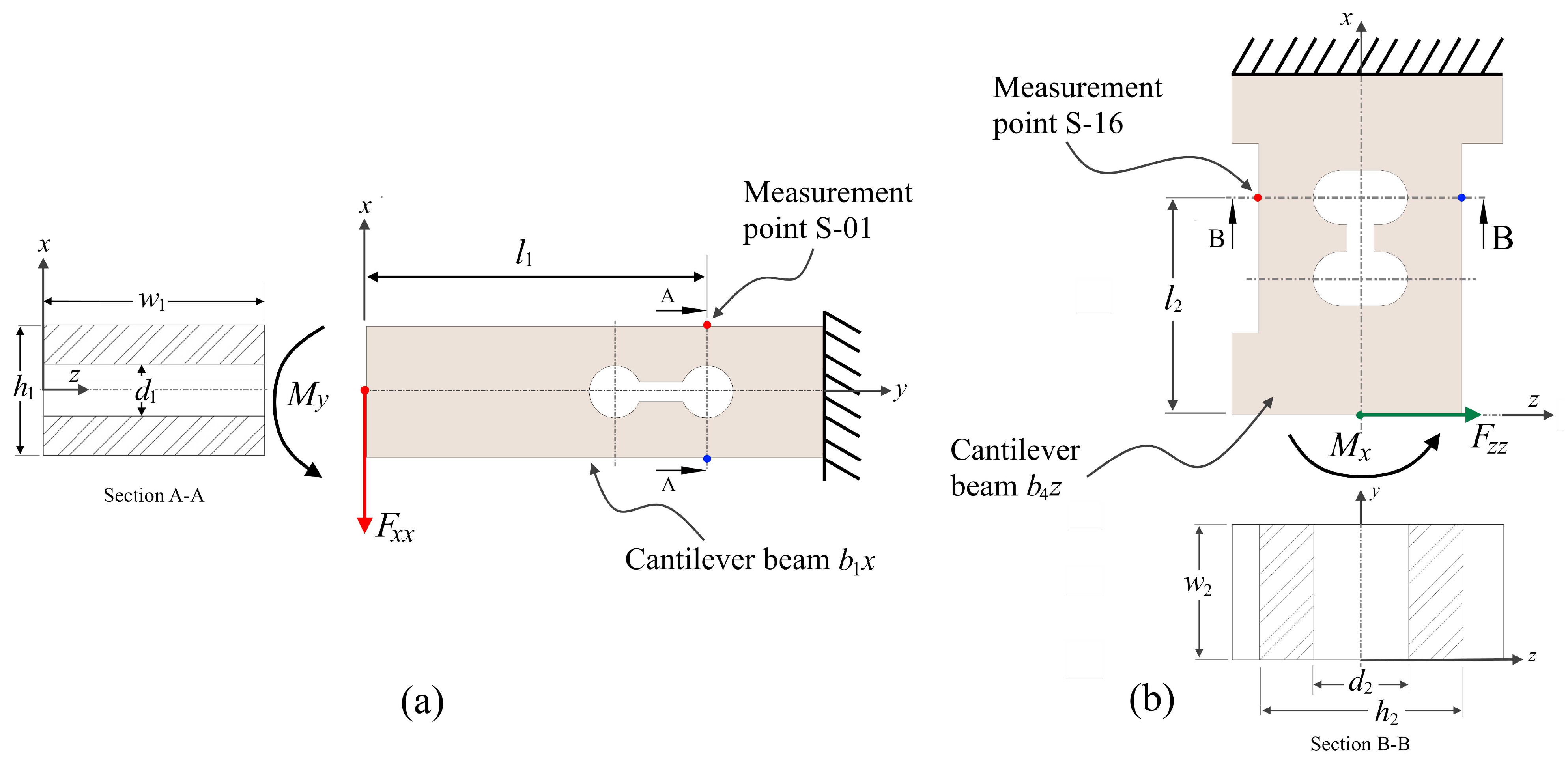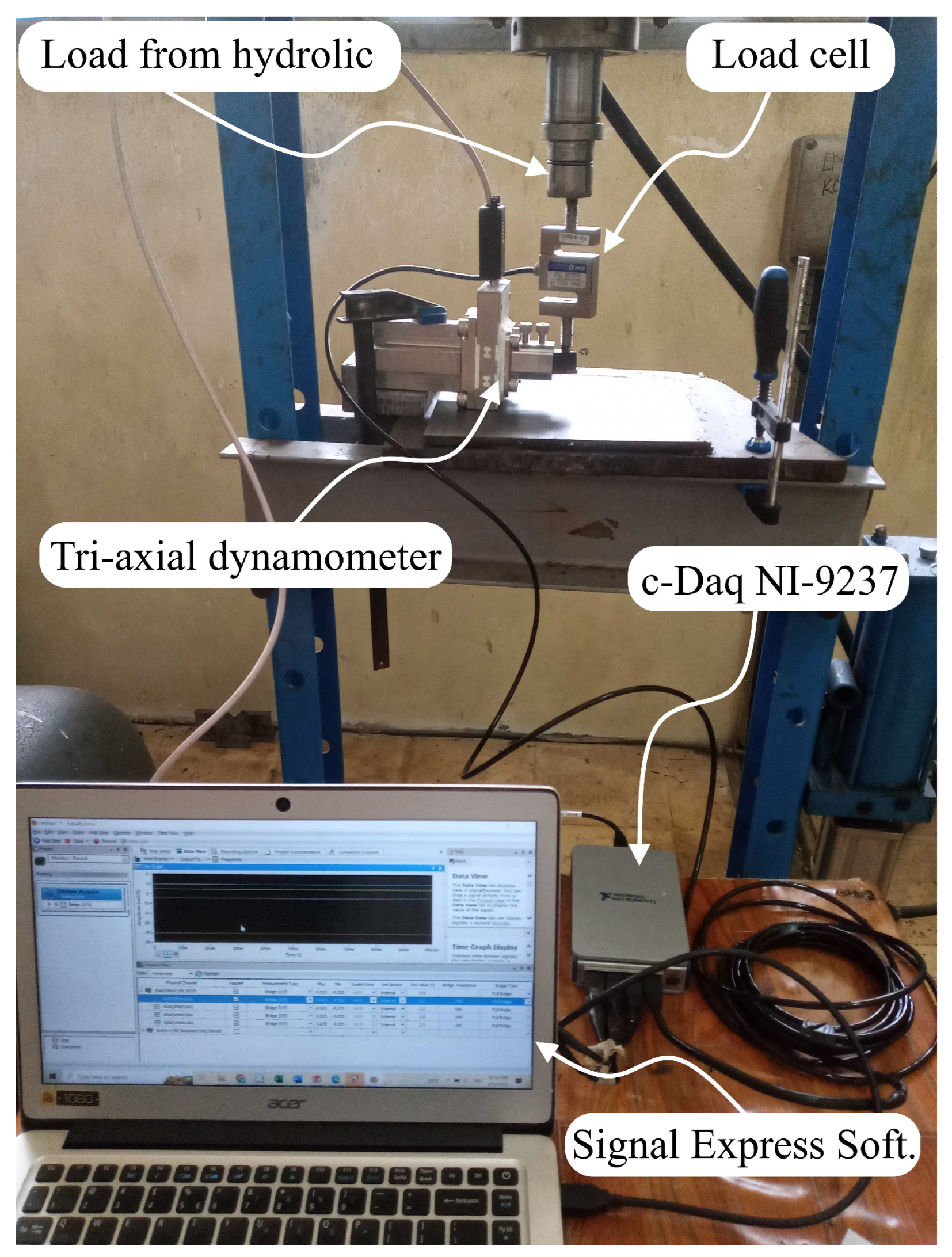Design and Development of a Tri-Axial Turning Dynamometer Utilizing Cross-Beam Type Force Transducer for Fine-Turning Cutting Force Measurement
Abstract
:1. Introduction
2. Concept Design of Turning Dynamometer
2.1. Cutting Force Component in Turning Process
2.2. Design of Force Transducer and Dynamometer
2.3. Analysis by Finite Element Method (FEM)
3. Fabrication of the Tri-Axial Turning Dynamometer
3.1. Piezoresistive Strain Gauge Arrangement in Cross-Beam Force Transducer
3.2. Constraction of Dynamometer and Data Acqusition System
4. Testing of Tri-Axial Turning Dynamometer
4.1. Static Calibration Test
4.2. Dynamic Test of Dynamometer
4.3. Performance Test of Dynamometer in Turning Operation
5. Conclusions
Author Contributions
Funding
Institutional Review Board Statement
Informed Consent Statement
Data Availability Statement
Conflicts of Interest
References
- Rizal, M.; Ghani, J.A.; Nuawi, M.Z.; Haron, C.H.C. Development and Testing of an Integrated Rotating Dynamometer on Tool Holder for Milling Process. Mech. Syst. Signal Process. 2015, 52, 559–576. [Google Scholar] [CrossRef]
- Totis, G.; Sortino, M. Development of a Modular Dynamometer for Triaxial Cutting Force Measurement in Turning. Int. J. Mach. Tools Manuf. 2011, 51, 34–42. [Google Scholar] [CrossRef]
- Horváth, R.; Pálinkás, T.; Mátyási, G.; Drégelyi-Kiss, Á. The Design, Calibration and Adaption of a Dynamometer for Fine Turning. Int. J. Mach. Mach. Mater. 2017, 19, 1–16. [Google Scholar] [CrossRef]
- Chen, Y.; Chen, F.; Li, Z.; Zhang, Y.; Ju, B.; Lin, H. Three-Axial Cutting Force Measurement in Micro/Nano-Cutting by Utilizing a Fast Tool Servo with a Smart Tool Holder. CIRP Ann.-Manuf. Technol. 2021, 70, 33–36. [Google Scholar] [CrossRef]
- Gong, T.; Zhao, Y.; Zhao, Y.; Wang, L.; Yang, Y.; Ren, W. Design and Manufacturing of a High-Sensitivity Cutting Force Sensor Based on AlSiCO Ceramic. Micromachines 2021, 12, 63. [Google Scholar] [CrossRef] [PubMed]
- Trolier-mckinstry, S.; Zhang, S.; Bell, A.J.; Tan, X. High-Performance Piezoelectric Crystals, Ceramics, and Films. Annu. Rev. Ofmaterials Res. 2018, 48, 191–217. [Google Scholar] [CrossRef] [Green Version]
- Wang, C.; Rakowski, R.; Cheng, K. Design and Analysis of a Piezoelectric Film Embedded Smart Cutting Tool. Proc. Inst. Mech. Eng. Part B J. Eng. Manuf. 2013, 227, 254–260. [Google Scholar] [CrossRef] [Green Version]
- Chen, X.; Cheng, K.; Wang, C. Design of a Smart Turning Tool with Application to In-Process Cutting Force Measurement in Ultraprecision and Micro Cutting. Manuf. Lett. 2014, 2, 112–117. [Google Scholar] [CrossRef] [Green Version]
- Li, X.; Wu, W.; Cheng, Y.; Liu, L. Structure Design and Optimization for a Cutting Force Measurement Tool with Embedded Nickel—Chromium Film Sensor. Adv. Mech. Eng. 2018, 10, 1–9. [Google Scholar] [CrossRef]
- Zhang, Y.; Wu, W.; Han, Y.; Wen, H.; Cheng, Y.; Liu, L. Design and Analysis of a Turning Dynamometer Embedded in Thin-Film Sensor. Micromachines 2019, 10, 210. [Google Scholar] [CrossRef] [PubMed]
- Cheng, Y.; Wu, W.; Liu, L.; He, Z.; Song, D. Structural Design and Optimization of a Turning Tool Embedded with Thin-Film Strain Sensors for in-Process Cutting Force Measurement. AIP Adv. 2022, 12, 015126. [Google Scholar] [CrossRef]
- Yaldız, S.; Ünsaçar, F. A Dynamometer Design for Measurement the Cutting Forces on Turning. Measurement 2006, 39, 80–89. [Google Scholar] [CrossRef]
- Rizal, M.; Ghani, J.A. Husaini Design and Construction of a Strain Gauge-Based Dynamometer for a 3-Axis Cutting Force Measurement in Turning Process. J. Mech. Eng. Sci. 2018, 12, 4072–4087. [Google Scholar] [CrossRef]
- Zhao, Y.; Zhao, Y.; Liang, S.; Zhou, G. A High Performance Sensor for Triaxial Cutting Force Measurement in Turning. Sensors 2015, 15, 7969–7984. [Google Scholar] [CrossRef] [PubMed] [Green Version]
- Zhao, Y.; Zhao, Y.; Wang, C.; Liang, S.; Cheng, R.; Qin, Y.; Wang, P.; Li, Y.; Li, X.; Hu, T. Design and Development of a Cutting Force Sensor Based on Semi-Conductive Strain Gauge. Sens. Actuators A Phys. 2016, 237, 119–127. [Google Scholar] [CrossRef]
- Zhao, Y.; Zhao, Y.; Ge, X. The Development of a Triaxial Cutting Force Sensor Based on a MEMS Strain Gauge. Micromachines 2018, 9, 30. [Google Scholar] [CrossRef] [PubMed] [Green Version]
- Alipanahi, A.; Mahboubkhah, M.; Barari, A. Cross-Sensitivity Control in a Novel Four-Component Milling Dynamometer for Simultaneous Measurement of Tri-Axial Forces and Torque. Measurement 2022, 191, 110788. [Google Scholar] [CrossRef]












| Force Direction | Cross-Talk Error (%) | ||
|---|---|---|---|
| Fx | Fy | Fz | |
| Fx | - | 1.62 | 5.13 |
| Fy | 0.79 | - | 4.66 |
| Fz | 5.17 | 1.62 | - |
| Force Direction | Avg. of Linearity Error (%) | Hysteresis Error (%) | Repeatability Error (%) | ||
|---|---|---|---|---|---|
| 10 N | 50 N | 100 N | |||
| Fx | 0.02 | 0.36 | 0.27 | 0.38 | 0.86 |
| Fy | 0.06 | 0.62 | 0.77 | 1.63 | 1.94 |
| Fz | 0.13 | 0.46 | 0.82 | 2.79 | 2.91 |
Publisher’s Note: MDPI stays neutral with regard to jurisdictional claims in published maps and institutional affiliations. |
© 2022 by the authors. Licensee MDPI, Basel, Switzerland. This article is an open access article distributed under the terms and conditions of the Creative Commons Attribution (CC BY) license (https://creativecommons.org/licenses/by/4.0/).
Share and Cite
Rizal, M.; Ghani, J.A.; Mubarak, A.Z. Design and Development of a Tri-Axial Turning Dynamometer Utilizing Cross-Beam Type Force Transducer for Fine-Turning Cutting Force Measurement. Sensors 2022, 22, 8751. https://doi.org/10.3390/s22228751
Rizal M, Ghani JA, Mubarak AZ. Design and Development of a Tri-Axial Turning Dynamometer Utilizing Cross-Beam Type Force Transducer for Fine-Turning Cutting Force Measurement. Sensors. 2022; 22(22):8751. https://doi.org/10.3390/s22228751
Chicago/Turabian StyleRizal, Muhammad, Jaharah A. Ghani, and Amir Zaki Mubarak. 2022. "Design and Development of a Tri-Axial Turning Dynamometer Utilizing Cross-Beam Type Force Transducer for Fine-Turning Cutting Force Measurement" Sensors 22, no. 22: 8751. https://doi.org/10.3390/s22228751
APA StyleRizal, M., Ghani, J. A., & Mubarak, A. Z. (2022). Design and Development of a Tri-Axial Turning Dynamometer Utilizing Cross-Beam Type Force Transducer for Fine-Turning Cutting Force Measurement. Sensors, 22(22), 8751. https://doi.org/10.3390/s22228751






